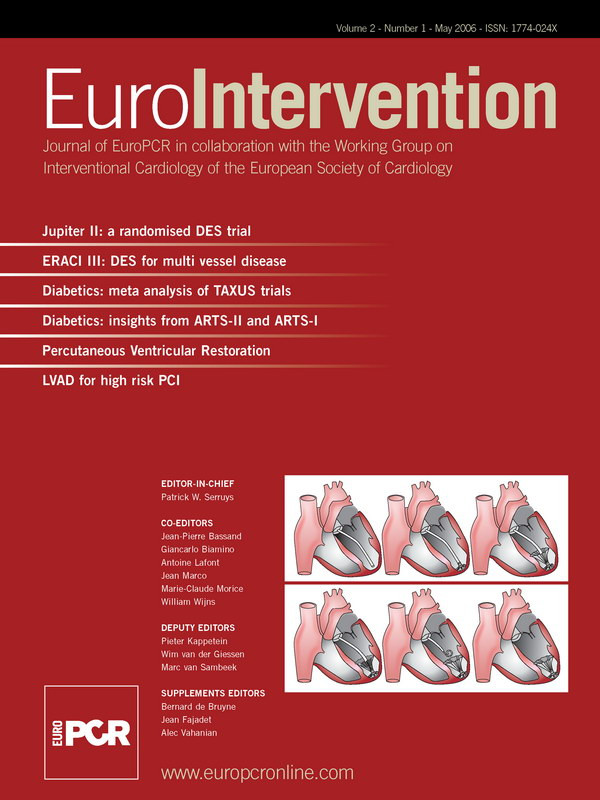Short term left ventricular support devices which can be rapidly deployed by cardiologists before or during circulatory collapse may save patients’ lives who otherwise would probably not reach the operating room in time. Several requirements need to be met by these devices: First, insertion must be accomplished percutaneously and it needs to be simple. Second, their efficiency needs to be high enough to create sufficient cardiac output even at the time of circulatory collapse, such as during ventricular fibrillation. Third, the frequency of complications associated with the operation of the system even over prolonged periods of time should be sufficiently low, so as not to neutralize the benefit conveyed by it.
A number of such devices have entered clinical service and have been tested under real life conditions. The most challenging of these situations is cardiogenic shock whose mortality with conservative treatment still remains at unacceptable level. Myocardial performance may remain severely depressed for several days even after successful revascularization, during this critical period most patients succumb to multi-organ failure. In the past it has been shown that the institution of intra-aortic balloon counterpulsation may achieve haemodynamic stabilisation in some cases; however in the majority of patients death was merely delayed. Although IABP can be rapidly instituted and the method of percutaneous insertion is simple, its major drawback is the lack of active cardiac support and its dependence on a minimal level of left ventricular function.
A totally different device has been tested several years ago, also in patients with cardiogenic shock. This device which has been marketed under the name TANDEM HEART® consists of a low speed centrifugal continuous flow pump which can provide up to 4L/min output independent of residual cardiac performance. It is virtually free of thromboembolic complications and haemolysis, however insertion of the 21f venous line into the left atrium requires a transseptal puncture which is regarded as a limiting factor in some institutions. Moreover, during prolonged operation beyond 4 days a significant number of bleeding events are likely to occur as a result of anticoagulation with heparin. Mortality in 18 patients with cardiogenic shock could be lowered to 44%, however no control group undergoing conservative treatment was recruited in this study.
A second field of potential employment of LVADs are high risk PCIs in patients with severely compromised left ventricular function, last remaining vessel or unprotected left main stenosis. Deployment of LVADs in this clinical setting is precautionary and the frequency of actual activation of the system is probably quite low. Thus, the assessment of its efficiency and the justification of this approach is quite difficult and depends on anecdotal evidence in individual patients. Moreover, the expenses for the prophylactic deployment of such a system, which as a rule amounts to several thousand US dollars must be weighed against the potential benefit.
In this issue of EuroIntervention their appear two studies which investigated a new device which has entered the market recently. This device known under the trade name Impella RECOVER®‚ utilizes a new approach combining easy deployment through a percutaneous femoral puncture with a high performance turbine inserted into the aortic root. It is the cardiological version of a larger device which has to be deployed surgically and can inject up to 5 L/min of blood into the aortic root (Impella RECOVER® LP5.0). After several improvements the rate of successful deployments is now close to 100% and haemolysis no longer seems to be a problem. A device of similar design has been mainly used surgically to treat patients in cardiogenic shock (Hemopump®).
Although the device has been designed to contribute up to 2.5 L/min of output at peak performance, it remains a matter of conjecture why output increased only from 4.4±1.9 L/min to 4.8 L/min (p<0.02) in the group with cardiogenic shock8. Was it because cardiac output was only marginally abnormal to begin with, or was there a problem with the pump’s positioning or operation? Positioning the turbine and the intake tube is quite sensitive and may affect the efficiency of the pump profoundly. Therefore in most patients with cardiogenic shock IABP was instituted parallel to the device. It would be of great value to learn how the pump operates in patients with severe cardiogenic shock with a very low cardiac index (<1 L/min2) and metabolic markers demonstrating tissue ischaemia, such as serum lactate. It is probably unrealistic to expect significant changes in cardiac output in patients with uncompromised circulation as in high risk interventions. Left ventricular unloading, however, was documented in patients with cardiogenic shock, as well as in high risk PCI as shown by a decrease in filling pressures.
In the second study9 the device was employed in high risk PCIs as protection in case of sudden ischaemia and haemodynamic deterioration. In all, in 12 patients PCI was uneventful and there was no need for haemodynamic support. However, a sudden increase in left ventricular volume was noted after inserting the pump through the aortic valve with the turbine operating at low speed. This could be the result of acute aortic regurgitation caused by the pump itself. Although volume overload could be neutralized by operating the pump at full speed it remains a matter of concern.
In summary both studies show that it is safe to operate this device in a clinical setting, however, before it can be recommended as a general measure in patients with cardiogenic shock, or during high risk PCIs, more data is required demonstrating its efficacy in severely compromised patients. Ideally, a randomized comparison with standard treatment (IABP) in a statistically meaningful number of patients should be initiated. At the present time there seems to be no system available which meets all three prerequisites defined at the beginning: efficiency, safety and simple deployment.

